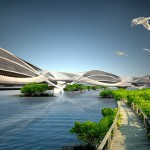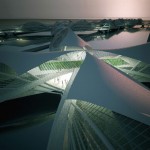Wetropolis images in Bangkok, Thailand by S+PBA
While most of the world follows the standard from dust to dust, ashes to ashes cycle, Bangkok prefers something wetter: from water to water. Almost 300 years after rising from the marshy banks of the Chao Phraya, it appears Bangkok will return to its watery origins. A recent UN study estimates that much of the metropolitan area will need to be abandoned by the middle of the century.
- Architect: S+PBA
- Name of Project: Wetropolis images
- Location: Bangkok, Thailand
Bangkokʼs population is growing by approximately 100,000 residents per year, just as the city itself is shrinking below sea level 4" per year. While most cities in this position could simply increase urban density by building up, this would only hasten Bangkokʼs subterranean slide. It is the blinding growth of Bangkokʼs built environment combined with the over-exhausted aquifers 2 m below the city surface that is causing the cityʼs physical depression. We are left then with a Post-Diluvian dilemma currently facing many world cities: do we sink or swim, flee or float?
With the city sinking 10 cm below a sea level that is rising by 40 cm annually, the safest place to create new architecture is above water. As it happens, Bangkok is surrounded by fields of water; brackish, polluted water remaining from an oversaturated shrimp farming industry whose very growth precipitated its own demise. Erstwhile shrimp farmers, who can no longer sustain shrimp life in their polluted plots, are currently selling their water-fields to developers who bury the water in housing tracts, or to the government, who hopes to restore the once thriving mangrove ecosystem.
While the governmentʼs aspirations would yield considerable environmental benefits to the metropolis, they cannot compete with the prices developers would pay for the equivalent water field. Developers, though paying the shrimp farmers slightly more, constitute an entirely negative environmental force by encouraging urban spread and commuting, by stifling the possibility for open space, and by simply burying brown-field environments with expensive flood-susceptible, cold weather foreign architecture. Each party is thus engaged in a win-lose proposition: suburbs will impair government mangroves, water will submerge suburbs, and shrimp farmers will lose their livelihood. City dwellers, developers, shrimp farmers and the environment all lose more than they gain.
This negative economy of loss occurs because Bangkok is still laboring under a very ante-diluvian mindset where flooding is considered a crisis and not a constant. Bangkok has always been flooded and the latest apocalyptic predictions only suggest that flooding will return with increased consistency. Once the city is submarine, can we even call this phenomenon flooding? Flooding implies a passing phase rather than a fixed environment, and yet, at the current juncture, water is much more predictable than land. In order to initiate a Post-Diluvian perspective that designs for water we must abandon the Metropolis in favor of the Wetropolis, and Architecture in favor of Aquatecture.
Towards a Post Diluvian Future will propose a Post-Diluvian prototype community that transforms principles from Thailandʼs centuries old traditions of flood-conscious aquatecture into a contemporary, sustainable and visually stunning Wetropolis. We will examine the entirely supra-marine stilt home community of Koh Pan Yii that hovers above the Andaman sea in Southern Thailand, successfully sustaining all of the typical functions of an urban community—schools, public spaces, hospitals, utilities, industry.
However, unlike Koh Pan Yii, we will provide a design solution that minimizes its foot print on the water, thereby enabling the continued cultivation of mangrove forests that will supply the community with carbon dioxide mitigating flora, with a natural effluent filtration system, with some of the only green open space in Bangkok and with moderate local shrimp farming. Our goal is not to replace the Metropolis with the Wetropolis, but to exceed it. We will design a community prototype elevated above the acres of underutilized shrimp farms that aligns the interests of shrimp farmers, urbanites, developers and the government by simultaneously sustaining mangrove restoration, modest shrimp farming, and a growing population in a sinking city that can thrive unaffected by the impending floods.
Blessing or Curse? Flooding, according to our community vision, will constitute a cathartic ablution, not a cataclysmic obliteration, of Bangkok. Water, detoxifying water, will wash away the 20th centuryʼs misguided substitutions of aircon for context, roads for canals, indoors for outdoors, anesthetic environments for aesthetic environments.
- Perspective 01
- Perspective 02
- Perspective 03
- Perspective 04
- Perspective 05
- Perspective 06
- Section
- Top View
- Intersection
- Ecosystem
Dr. EMAD HANI ISMAEEL
Ph.D. in Technologies for the Exploitation
of the Cultural Heritage .
Senior Lecturer in the Dept. of Architecture
College of Engineering , University of Mosul
Mosul - Iraq .
E-mail: emadhanee@yahoo.com
Web Site: http://sites.google.com/site/emadhanee/
Tel : +964 (0)770 164 93 74




















تعليقات
إرسال تعليق